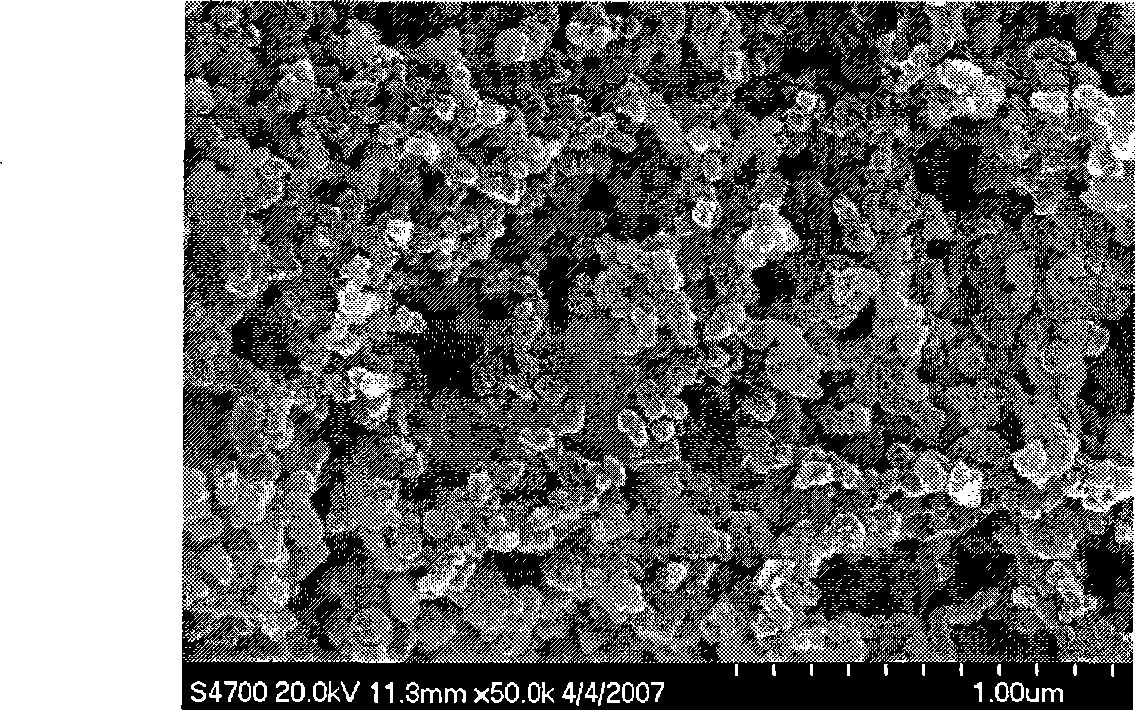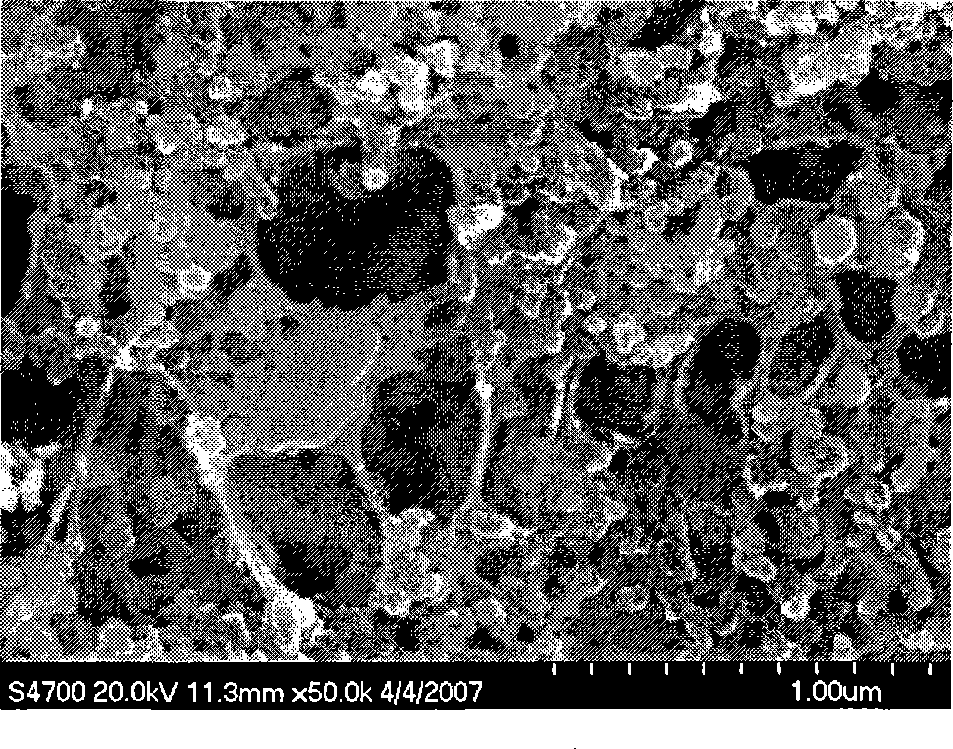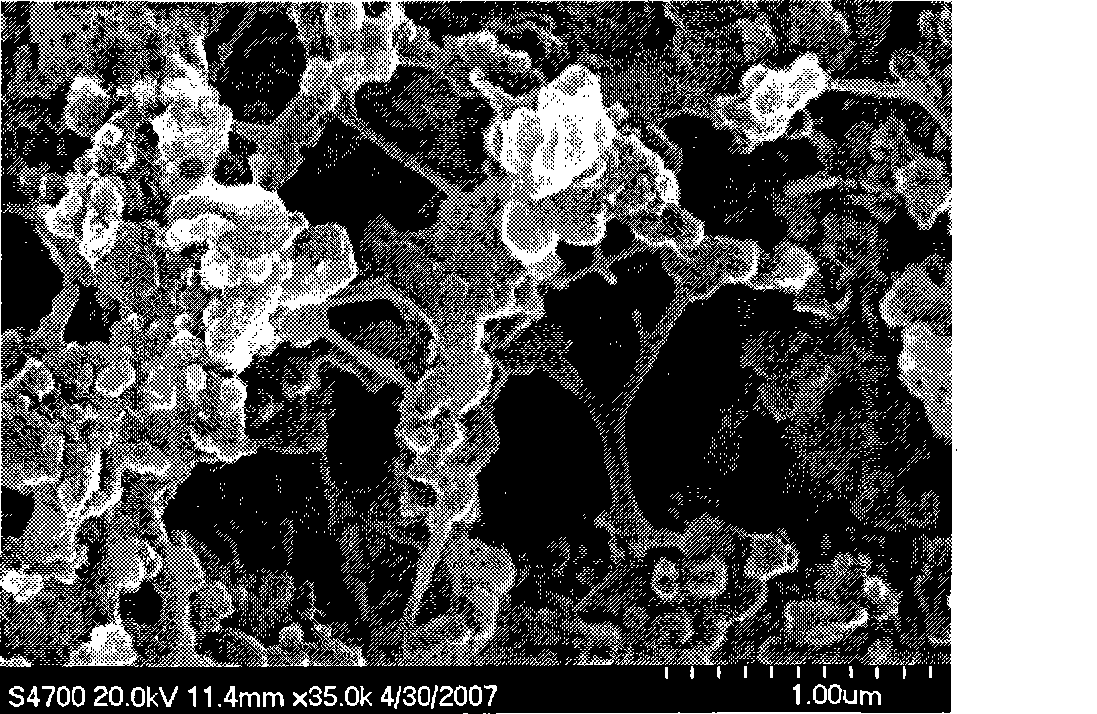Positive pole plate of lithium-sulfur cell and manufacturing method thereof
A cathode electrode, lithium-sulfur battery technology, applied in battery electrodes, electrode manufacturing, active material electrodes, etc., can solve the problems of cathode active material elemental sulfur or polysulfide loss, poor adhesion, etc. The effect of stability and cycle stability, strong adhesion and good cycle performance
- Summary
- Abstract
- Description
- Claims
- Application Information
AI Technical Summary
Problems solved by technology
Method used
Image
Examples
Embodiment 1
[0029] At room temperature, fully swell the gelatin in water, and then dissolve it in a water bath at 60° C. to prepare an aqueous gelatin solution with a concentration of 3% by mass, and set aside.
[0030] Preparation of the positive electrode sheet: mix 7 parts by mass of sublimed sulfur and 2 parts of acetylene black in proportion, grind them evenly, then add a binder solution containing 1 part of gelatin solid, grind to make the binder solution and the active material Fully and evenly mixed with acetylene black to make a positive electrode material slurry, coated on an aluminum foil current collector, and vacuum-dried for 10 hours to obtain a positive electrode active material, a conductive agent and a gelatin binder with mass percentages of 70%, 20%, and 10% % positive pole piece.
[0031] The pole piece prepared above is used as the positive pole, Li is the negative pole, the diaphragm is made of polypropylene film, and the electrolyte is 1mol / L LiClO 4Solution, the so...
Embodiment 2
[0033] At room temperature, fully swell the gelatin in water, and then dissolve it in a water bath at 60° C. to prepare a 2% gelatin aqueous solution for later use.
[0034] Preparation of the positive electrode sheet: mix 6 parts by mass of sublimed sulfur and 3 parts of acetylene black in proportion, grind them evenly, then add a binder solution containing 1 part of gelatin solid, grind to make the binder solution and the active substance Fully and evenly mixed with acetylene black to make a positive electrode material slurry, coated on an aluminum foil current collector, and vacuum-dried for 10 hours to obtain a positive electrode active material, a conductive agent and a gelatin binder with mass percentages of 60%, 30%, 10% % positive pole piece.
[0035] Because the gelatin binder used has good dispersibility for the conductive agent, the components of the pole piece are uniformly dispersed without obvious agglomeration, such as figure 1 shown. Thus, the discharge perfo...
Embodiment 3
[0038] At room temperature, fully swell the gelatin in water, and then dissolve it in a water bath at 60° C. to prepare a 4% gelatin aqueous solution for later use.
[0039] Preparation of positive electrode material: Mix 7 parts by mass of sublimed sulfur and 2 parts of acetylene black in proportion, grind them evenly, then add a binder solution containing 1 part of gelatin solid, and grind until a uniformly dispersed positive electrode material slurry is formed , and coated on the aluminum foil current collector, frozen at -40 ° C for 4 hours to form an ice crystal structure, and then vacuum-dried for 12 hours to obtain a positive active material, a conductive agent and a gelatin binder with a mass percentage of 70%, 20%, 10% positive pole pieces with microporous structure.
[0040] The pole piece prepared above is used as the positive pole, Li is the negative pole, the diaphragm is made of polypropylene film, and the electrolyte is 1mol / L LiClO 4 Solution, the solvent is D...
PUM
 Login to View More
Login to View More Abstract
Description
Claims
Application Information
 Login to View More
Login to View More - R&D
- Intellectual Property
- Life Sciences
- Materials
- Tech Scout
- Unparalleled Data Quality
- Higher Quality Content
- 60% Fewer Hallucinations
Browse by: Latest US Patents, China's latest patents, Technical Efficacy Thesaurus, Application Domain, Technology Topic, Popular Technical Reports.
© 2025 PatSnap. All rights reserved.Legal|Privacy policy|Modern Slavery Act Transparency Statement|Sitemap|About US| Contact US: help@patsnap.com



